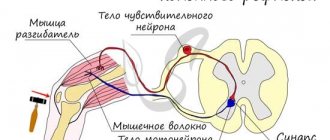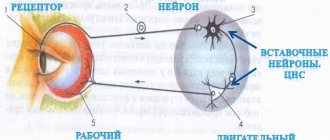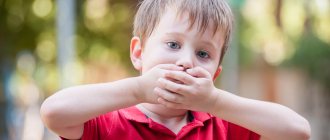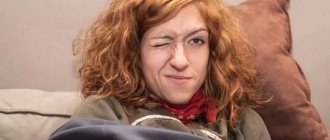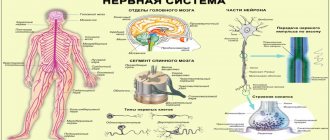Features of the formation of neurosis in a child
Next, consider the origin of childhood neuroses.
Their peculiarity in children is their formation against the background of personality immaturity. To understand, the personality of children is determined by the type of upbringing in the family.
It is worth highlighting the main “inadequate” types of upbringing:
- Insufficient attention to the baby is “hypocustody.”
- Excessive attention is “overprotection”.
- Cruel upbringing.
- Authoritarian parenting.
As a rule, improper upbringing can harm the development of a child’s personality and temperament. As a result, negative character traits and inadequate reactions on the part of the child appear. Sooner or later, this leads to a feeling of inferiority, against the background of which any negative external influence can lead to neurosis. The role of a negative factor can be: a rude word, a loud remark, a change in living conditions and much more.
Given the immaturity of personality in children, typical forms of neurosis rarely develop. More often they have simpler disorders - systemic neuroses. They can manifest themselves in any organ and organ system. It is believed that the choice of damage to one or another organ depends on the hereditary susceptibility (weakness) of the organ or body system. Such weak points in children are often the speech-motor system (formation of stuttering) and the urinary system (development of enuresis).
There is also another development mechanism: a combination of increased nervous tension and the performance of a certain action or movement at this moment. So, this action or movement can lead to the formation of tics in the baby. Thus, neuroses in childhood most often manifest themselves as tics, stuttering and enuresis. In the absence of treatment, systemic neuroses with age often become “classical”, as in adults.
Stuttering is common in children with neuroses.
Hyperkinesis (tics) in children
Tics are sudden, involuntary, violent, stereotyped, repeated, irregular, short-term movements of one muscle, group of muscles or parts of the body. Tics can also manifest as sound abnormalities, expressed as shouting of a sound, syllable, or word.
Tics appear in childhood, mainly from five to ten years, and are more common in boys, but they also occur in girls (although much less frequently). In most cases, they can be corrected and disappear by the age of fifteen. Tics are not always completely involuntary and unconscious; sometimes they can be slowed down or weakened by an effort of will.
There are many varieties of ticks - from the simplest to the very complex. They may not bother the child at all, he may not even notice his involuntary movements, communicate freely with peers (this could be single blinks or other simple motor tics). But tics can also have a pronounced form - it is very difficult for a child with such tics to be around people, and they significantly complicate his life. He cannot express thoughts or perform any actions without interference.
Treatment of tics is a very difficult task, the solution to which is primarily based on a correctly identified cause. With tics, there is often an undulating course of the disease - periods of exacerbations and remissions. During periods of exacerbation of tics, monitoring the child by a neurologist is especially important.
At the DoctorNeuro Center for Speech Neurology, you will undergo a full examination under the supervision of an experienced neurologist. Based on the examination results, the doctor will determine the cause of the tics, depending on this, prescribe drug therapy, and, if necessary, decide on the introduction of additional (non-drug) correction methods and monitor the progress of treatment.
The task of a qualified neurologist is to strike a balance between the extent to which tics affect quality of life and the collateral harm that therapy can cause. And make a decision in favor of the patient
Krivtsova Yulianna Pavlovna, Neurologist, doctor of the first category
SURVEY
Neurologist
In case of tics, a detailed neurological examination is required, including an examination by a neurologist, an EEG, an ultrasound scan of the vessels of the head and neck, and sometimes an MRI of the brain. The scope of the necessary examination is determined by the neurologist. As a result of the examination, the neurologist determines the cause of the disease and prescribes treatment.
EEG
An electroencephalogram is performed to make a differential diagnosis with epileptic conditions, as well as to assess the level of bioelectrical activity of the brain. Laboratory examination
If an infectious cause of tics is suspected, a biochemical blood test for markers of inflammation (acute phase proteins) may be prescribed. Immunologist
For the same reason, a consultation with an immunologist and additional immunological examination may also be necessary. Neuropsychologist
A neuropsychologist assesses the state of the child’s higher mental functions (memory, thinking, motor sphere, perception, etc.), as well as an assessment of the emotional-volitional sphere.
During neuropsychological diagnostics, children suffering from tics most often experience disturbances in attention, visual and auditory perception, speech, and motor skills. For example, when examining the safety of a child’s motor functions, insufficient smoothness of movements, slowness of movements, and a violation of the correct sequence of the motor program are noted. Also, such children often have difficulties in self-organization, impulsivity, difficulties in programming, regulating and controlling their own behavior.
TREATMENT
After establishing the cause, the neurologist prescribes the necessary therapy. In some cases, anti-inflammatory and immunomodulatory therapy is additionally prescribed to sedative therapy (if the cause of tics is an infectious pathogen).
There are no standard treatment regimens for tics. Selection of therapy is always an individual process. The range of sedative drugs used varies from the “weakest”, mainly of plant origin, to “serious” drugs from the group of antipsychotics. A neurologist always weighs the effectiveness of the therapy used and possible side harm and applies a treatment strategy “from weak to strong drugs.” That is why the process of treating tics always requires intermediate observations from a neurologist; the doctor must monitor the results of his therapy. Depending on the dynamics and severity of tics, the interval of contacting a neurologist can be several days, several weeks, or several months. Sometimes you have to take medications for a long time, several months, and sometimes even years. It all depends on the severity of the disease.
ADDITIONAL (NON-DRUG) TREATMENT
Often, a neurologist can prescribe additional (non-drug) treatment methods: massage of the cervical-collar area, electric sleep, osteopathic treatment.
If necessary, the neurologist can also prescribe a course of sessions with a child neuropsychologist and a child psychoneurologist, whose help is especially effective if the tics were provoked by a stressful situation.
Transcranial magnetic stimulation (TMS) is an effective new treatment method. This is a unique modern non-invasive technique for the treatment of neurological disorders. Today, both in domestic and foreign scientific literature, there is a fairly large number of studies on the treatment of tics using TMS. The principle of operation of TMS is the painless and safe effect of short-term magnetic pulses on the nerve cells of the cerebral cortex. In the case of treating tics, a treatment mode that “inhibits” excessive neuronal activity is used.
The experience of using the TMS technique at our Center has a sufficient number of examples of treating tics with positive results.
Exacerbation of tics
As a rule, the debut and exacerbation of tics occur during two age periods of hormonal changes and active growth of the child’s body - 6-7 years (primary school) and puberty (adolescence), which in recent years has tended to manifest itself earlier at 10-11 years. .
Exacerbations of tics often occur against the background of previous infections, as well as stress, fear, or a traumatic situation.
Types of ticks
Based on the nature of clinical manifestations, tics are divided into motor (motor) and auditory (vocal).
The most common motor tics are blinking, nose movements, various grimaces, head tilts, body bends and turns, and jumping. Vocal tics manifest themselves both as individual sounds (this could even be a cough or bark) or by shouting out entire words.
According to the severity of tics, simple tics (single), multiple common (when several types of tics are noted) and generalized (when both motor and vocal tics are present, almost all groups of facial and trunk muscles are involved) are distinguished.
Causes
The causes of tics can be different. The main reasons include:
Hereditary cause - tics are observed in the family in relatives and parents. The severity of hereditary tics can vary - from single blinks to a severe form of tics, manifested by multiple motor and sound phenomena, up to coprolalia (this severe form of tics is called Gilles de la Tourette's disease, after the name of the doctor who described this hereditary disease).
The cause of tics can be stress, fear, or a traumatic situation. As a rule, such children experience increased anxiety, sleep disturbances, emotional instability, and neurotic disorders.
In children, tics often occur after an infection. It often happens that a child seems to have already recovered from a cold, his tests have returned to normal, but his cough continues. Pediatricians treated him for a long time and unsuccessfully, and in the end it turned out that the cough was a vocal tic. This example, in particular, convincingly demonstrates the need for a thorough examination to make the correct diagnosis. Motor tics are also often a consequence of infection. There is a separate group of tics that occur after a streptococcal infection. They are symptoms of a complex autoimmune syndrome caused by streptococcus.
The mechanism for the development of tics is based on a metabolic disorder of certain substances (neurotransmitters) involved in the transmission of nerve impulses. The subcortical formations of the brain are affected - this is the part of the brain that is normally controlled by the cortex. With tics, it begins to function independently, which is why involuntary movements occur.
Types and symptoms of neuroses
There are such types of general neuroses as:
- Hysteria . In children, this condition manifests itself as an excessive, inadequate reaction to dissatisfaction with something. Children with hysteria often “fake it.” They can achieve what they want by manipulating their parents. Manipulation may involve simulating symptoms of the disease. At the same time, the doctor, examining the baby, does not find objective signs of the disease.
- Neurasthenia . In children it manifests itself as irritability and weakness. It is not uncommon to experience violent reactions to minor remarks or actions. Characteristic symptoms of neurasthenia are also: mood swings, increased fatigue, decreased performance, headache, palpitations, sleep disturbance. Pediatricians, examining these children, often identify well-known vegetative-vascular dysfunction.
- Obsessive states . They develop in children with certain psychological characteristics: fearfulness, suspiciousness, indecisiveness. The formation of various fears is typical from an early age. Most sick children develop a variety of defensive reactions in the form of obsessive actions (flapping hands, frequent hand washing, jumping, etc.). At an older age, obsessive thoughts, doubts, and more may appear. At the same time, children may realize the absurdity of their actions and try to fight them.
Below we consider the most common forms of neuroses in children:
- Tiki . Often preceded by obsessive states and actions. They are characterized by stereotypical contractions of individual muscle groups. At an early age, frequent eye blinking often occurs. As it progresses, other muscle groups may be involved in the process (twitching the nose, opening the eyes, raising the eyebrows, lifting the shoulders, and much more). After suffering from acute respiratory viral infections, such children may develop respiratory tics: coughing, coughing, snorting, etc.).
After suffering from acute respiratory viral infections, children may develop respiratory tics (coughing, coughing, snorting, etc.).
- Stuttering . You can also come across another name - logoneurosis. They are synonymous words. Stuttering is a speech disorder associated with convulsive contraction of individual muscle groups of the speech-motor apparatus. You can find out more about the manifestation and treatment of this problem in our article.
- Enuresis . Represents bedwetting. Enuresis is a neurosis only if it develops against the background of psychological trauma or changes in living conditions (visiting kindergarten for the first time, the birth of a brother or sister, etc.). The connection with the environment and situation in which the baby may be is quite characteristic. Over time, children develop a feeling of inferiority due to their illness. At an older age, negative character traits may appear: lack of restraint, anger, irritability. In some cases, enuresis can develop along with encopresis (fecal incontinence).
Neurosis, like other diseases, goes through a number of conditional stages. The effect of treatment depends on the timeliness of assistance. A fairly simple rule: the earlier the help is provided, the more favorable the effect of treatment .
Treatment of neuroses in children: what not to do
The fact that a child begins to bite his nails or pull out his hair causes many different feelings and thoughts among close adults. I will dwell on popular misconceptions.
You can’t expect it to “go away on its own.” Some parents tend to hush up the problem. They hope the child will grow up and everything will somehow be resolved on its own. Yes, many of those who bit their nails or even wet the bed as children get out of the habit. But how much suffering the child endured before he grew up! Ridicule from peers, scolding from adults, feelings of self-worth. All this leaves an indelible mark on the soul and can interfere with success in life.
You can't blame yourself. Other parents are angry with themselves and feel worthless and incompetent. They torment themselves with thoughts: “Why? I’m a good mother, what have I done!” They are embarrassed to contact a specialist, fearing that he will scold them. Due to the strong feelings of the parent, the child’s neurosis may intensify even more.
It's not mom's fault
You can't blame the child. It's easy to believe that a child deliberately pulls out his hair or wets his pants to annoy his parents. For “disobedience” and threats to parental authority, the child is punished more severely in order to restore the balance of power. Resentment and fear are added to neurosis, and the situation worsens.
“Prevention of psycho-emotional stress in preschool children”
Dear friends, we are pleased to introduce you to Yulia Konstantinovna Kuzmenko, a teacher of the highest qualification category at MBDOU combined kindergarten No. 303 in the city of Nizhny Novgorod, Nizhny Novgorod region . Today, Yulia Konstantinovna is pleased to share with us her professional experience in the prevention of psycho-emotional stress in preschool children. The target audience of the article is parents and educators.
Brief commentary on the article from Yulia Konstantinovna:
“Taking into account the mental state of the child is one of the most pressing problems of modern educational practice, which is designed to ensure the physical and mental health of the younger generation. In science, a mental state is considered as a mental phenomenon that is quite complex in structure, reflecting the interaction of a person with the living environment. It is necessary to teach how to determine your psychophysical state, starting from childhood.”
Educational reading...
“Prevention of psycho-emotional stress in preschool children”
The emotional life of children aged 3-7 years is characterized by the following features:
- children begin to better understand the feelings and emotions of other people, accurately recognize them and learn to respond adequately to them;
- the spontaneity and openness of one’s experiences are preserved;
- children are already able to express their emotions in words, they already have clear ideas about the basic emotions of a person;
- a general emotional background of mood is formed, which depends on the degree of well-being in the family, successful communication with parents and peers;
- feelings of sympathy, love and affection, empathy and complicity arise; the first friendly feelings appear; aesthetic feelings are formed; the child begins to express intellectual feelings: curiosity, surprise and joy about solving cognitive problems;
- Children can easily get offended, cry, and in a conflict situation they vigorously express their feelings, but quickly forget the grievances.
Taking into account the mental state of the child is one of the most pressing problems of modern educational practice, which is designed to ensure the physical and mental health of the younger generation. In science, a mental state is considered as a mental phenomenon that is quite complex in structure, reflecting the interaction of a person with the living environment. It is necessary to teach how to determine your psychophysical state, starting from childhood.
The main signs of stress in children.
1. Depressed mood.
2. Poor sleep (difficulty falling asleep and sleeping very restlessly).
3. The baby becomes touchy for no reason, often cries for insignificant reasons or, conversely, becomes too aggressive.
4. Absent-mindedness, forgetfulness, lack of self-confidence, in one’s abilities, restless restlessness.
5. Fatigue after exercise, which recently was very easy.
6.Antics, stubbornness, fear of contacts, desire for loneliness.
7. Constantly chews or sucks on something. Persistent loss of appetite.
8.Trembling hands, shaking the head, twitching of the shoulders, playing with the genitals, night and even daytime urinary incontinence.
9. They begin to lose weight, look exhausted, or, on the contrary, they experience symptoms of obesity.
10.Memory disorders, difficulties with imagination, poor concentration, loss of interest in everything that previously caused activity.
All of the above signs can indicate that the child is in a stressful state only if they have not previously been observed.
The main means of prevention and correction of psycho-emotional stress in children:
1. Physical activity (health-improving morning exercises, health-improving jogging, psychotherapeutic walk, health-improving games, rhythmoplasty, vibration gymnastics, musical-rhythmic gymnastics). I.P. Pavlov said that any physical activity gives muscular joy, creating a stable mood.
2. Properly organized sleep. During sleep, physiological balance in the body is restored.
3. Nutrition. It is important not only to have the proper set of products to ensure the normal growth and development of the child, but also the organization of nutrition itself. It is reasonable to spend meals as a big relaxation break.
4.Water hardening procedures. Effectively relieve tension and stress.
5. Maintaining a daily routine.
6. Training in psycho-self-regulation of the state. Research confirms that children learn autogenic training techniques much faster and with greater effect than adults. This is due to the fact that children have a vivid imagination, which helps them quickly and easily enter the desired image. Most exercises are offered in a playful way.
How to relieve tension in a child? Recommendations for teachers and parents.
1.Unconditionally accept and respect the child. If you are angry with your child, you need to express your dissatisfaction. But not by the child as a whole, but by his individual actions. You can condemn a child's actions, but not his feelings. Since he has feelings, it means there is a reason for it. Actively listen to his experiences and needs. Don't interfere with activities he is doing well. Help when he asks. Support your successes. Share your feelings. Resolve conflicts constructively. Use friendly phrases in everyday communication. Hug at least 4, and preferably 8 times a day. Be (read, play, study) together. 2.Health games. Games in this series are designed to prevent fatigue caused by intense intellectual stress. In addition to relaxation, they perform communicative, entertaining and educational functions.
For example:
"Heron". Children are asked to take off their shoes and stand in a circle at a signal. The presenter announces a competition for the best heron. At the signal, children must bend their right leg at the knee, turn it 90 degrees in relation to the left and press the foot to the left thigh as high as possible. Hands on the belt. Eyes closed. It is necessary to hold out in this position for as long as possible. The game trains the vestibular system and develops the ability to concentrate, and always makes children laugh a lot.
"Geese." Children line up in one line, squat down and, at the command of the leader, run in a goose-step waddle. The fastest ones win. The game strengthens the calf muscles and trains the cardiovascular system.
"Cat". The presenter invites the children to kneel down and place their palms on the floor. Now we will portray a cat. At first the cat is unhappy. She arches her back as much as possible upward. Now the cat is stretching. The back bends down. Movements should be energetic, but at the same time smooth and graceful. The movements alternate for 2 seconds. Then the children are asked to lie on their backs, quickly and gracefully roll over on one side or the other, while simultaneously performing stretching movements with their arms and legs on one side and curling movements on the other, as a cat does when it is very happy. The exercise is performed for 2 seconds. The game promotes emotional uplift, creates a feeling of relaxation and trains the back and abdominal muscles, developing flexibility and strength.
3. Parents are often concerned about their children’s lack of composure, excessive activity, or, on the contrary, isolation, timidity, and often aggressiveness and tearfulness. A balanced, joyful child suddenly becomes conflicted and restless. All these are signs of internal psycho-emotional stress, a consequence of some “childhood” problem that adults have not yet figured out. How to help a child in such moments? The most correct thing is to teach him to help himself, that is, to introduce him to methods of self-regulation.
For example:
“Pull yourself together” (for children from 5 years old). The child is told: “As soon as you feel that you are worried, you want to hit someone, throw something, there is a very simple way to prove your strength: clasp your elbows with your palms and press your hands tightly to your chest - this is the pose of a self-possessed person.
“A mountain off your shoulders” (for children from 5 years old). When you are very tired, it’s hard for you, you want to lie down, but you still need to do something, throw the “mountain off your shoulders.” Stand with your legs wide apart, lift your shoulders, roll them back and lower your shoulders. Do this exercise 5-6 times and you will immediately feel better.
“Save the chick” (for children from 4 years old). “Imagine that you have a small helpless chick in your hands. Extend your arms, palms up. Now warm it up, slowly, fold your palms one finger at a time, hide the chick in them, breathe on it, warming it with your even, calm breath, put your palms to your chest, give the chick the kindness of your heart and breath. Now open your palms and you will see that the chick has joyfully taken off, smile at him and don’t be sad, he will fly to you again!”
4. How to help an aggressive child?
- create conditions for relieving stress through movement (sports, competitions, games, hikes);
- teach your child to properly guide, show their feelings without offending others;
- if a feeling of resentment, anger, anger overwhelms a child, you can go to another room where there is no one, and there express everything that has accumulated;
- Invite your child to hit a special pillow, tear up a newspaper, crumple and tear a “sheet of anger,” and hit a ball;
- redirect the child’s attention, offer to dance a dynamic, energetic dance to rhythmic loud music, sit (lie down) to slow music, relax, sing;
- let the child draw his state (anger, pain, aggression);
- Invite your child to inflate a balloon (you can mentally), “blow” all negative thoughts, feelings, and emotions out of yourself into it, tie the balloon tightly and release it out the window.
The place of teachers and parents is next to the child, perhaps a little in front. Do not suppress, do not crush, do not punish, but warn, give the child the right to decide. Encourage and uplift and accept the child unconditionally. Love him not because he is handsome, smart, capable, but just like that, simply because he is. I would like to see every child happy, and not burdened with worries beyond their age. Every adult, if he loves, understands and has not forgotten how to play, can help a child grow up happy and satisfied with those around him, both in the family and in kindergarten.
Literature.
1.Medical and psychological service in a preschool educational institution: Organization of work. Ed. E.A.Karalashvili. – M., 2006.
2. Features of the emotional development of a preschooler aged 3-7 years. Ed. E.I. Shapiro. – St. Petersburg, 2011.
3.Prevention of psycho-emotional stress in preschool children. Alyamovskaya V.G. Petrova S.N. M.: - Scriptorium. 2002.

